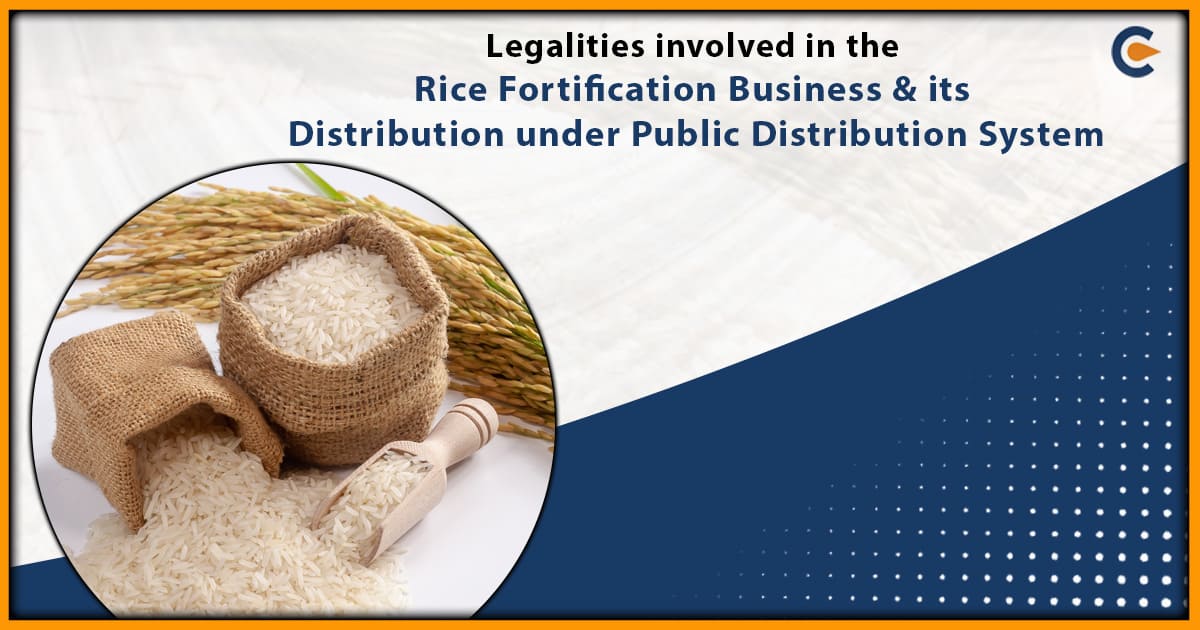“Fortification” refers to the intentional increase in essential micronutrients in food in order to enhance its nutritional value and promote public health while minimizing potential health risks. It is a very important step towards paddy processing. Our Prime Minister has made a significant commitment to combat the widespread issue of malnutrition-related anaemia by mandating the fortification of rice in all social safety net programs by 2024. Rice fortification involves the addition of micronutrients such as iron, folic acid, and vitamin B12, and it serves as an effective, preventative, and cost-efficient complementary approach to addressing nutritional deficiencies in a relatively short timeframe. However, the legalities involved in the Rice Fortification Business have been focussed on in this write-up.
Benefits of Fortified Rice Kernels (FRK)
India has made impressive strides in reducing stunting and anaemia among children in the past decade. However, anaemia continues to affect over half of the children and women in the country. The World Health Organization (WHO[1]) has classified anaemia among women and children as a “severe” public health issue that requires immediate attention. Recent statistics indicate a rise in anaemia levels among women and children in 16 out of 22 States/Union Territories, as the National Family Health Survey (NFHS-5) reported.
Iron deficiency anaemia has been identified as the primary cause of disability for the past decade and has contributed to 20% of direct maternal deaths and 50% of associated maternal deaths in India. Additionally, the economic burden of this condition is equivalent to approximately 4% of the country’s GDP. Apart from iron, deficiencies in other micronutrients such as vitamin B12, vitamin A, folate, and zinc also contribute to the increasing levels of anaemia. These deficiencies are largely attributable to imbalanced and inadequate diets.
The Prime Minister’s announcement has provided a significant boost to strengthen the rice fortification ecosystem before it transitions into an automatic mode. The BIS has also included the Legalities involved in the Rice Fortification Business that such as:-
- IS 17780: 2021 ‘Fortified Rice – Specification
- IS 17782: 2021 ‘Fortified Rice Kernels – Specification
- IS 17781: 2021 ‘Vitamin & Mineral Premix for Manufacturing Fortified Rice Kernels – Specification’
- IS 17853: 2022 ‘Equipment for Manufacture of Fortified Rice Kernel – Specification’
- IS 17854: 2022 ‘Equipment for Manufacture of Fortified Rice – Specification’
Types of fortification
Essentially, there are four categories of food fortification, namely:-
- Mass fortification
- Mass fortification involves fortifying foods that are widely consumed by the general population.
- It is considered the most suitable approach when a large portion of the population is at risk of nutritional deficiencies.
- Examples include fortification of cereals, condiments, milk, oil, and vegetables.
- Typically, this type of fortification is mandated or regulated by the government.
- Targeted fortification
- Targeted fortification focuses on fortifying foods specifically intended for particular sub-groups of the population.
- Examples include complementary foods for infants and young children, foods for school feeding programs, and specialized products for pregnant and lactating women.
- Market-driven fortification
- Market-driven fortification involves food manufacturers voluntarily fortifying their products with specific micronutrients as a business-oriented initiative.
- However, these manufacturers must comply with government-regulated limits for fortification.
- Market-driven fortification is more commonly observed in industrialized countries compared to developing nations.
- Other types of fortification
a) Household and community fortification
- Household and community fortification refers to fortifying foods with one or more micronutrients at the household level.
- This approach combines elements of both supplementation and fortification.
- Examples include multiple micronutrient powders and soluble tablets.
- This method is effective in situations where universal fortification is not feasible, although it is generally costlier than mass fortification.
b) Bio-fortification of staple foods
- Bio-fortification involves breeding and genetically modifying plants to increase their nutrient content.
- While this method of fortification appears to be sustainable, further research is necessary to assess its safety, cost-effectiveness, and health impacts.
Statement of Purpose (SOP)
The key points of the Standard Operating Procedure (SoP)1 in the Legalities involved in the Rice Fortification Business that need to be followed are as follows:-
- Manufacturers will have a one-year time period to transition from non-BIS-certified machinery to BIS-certified machinery.
- A Certificate of Analysis (CoA) must be obtained from an independent third-party NABL-accredited laboratory, as per section 43 of the FSS Act 2006 and FSS Regulation 2018.
- FRK manufacturers must maintain records of CoAs, other test records, FRK standardization count/BET, etc. The self-certification procedure adopted by FRK manufacturers will be checked by the S&R division of DFPD, with further testing by FCI during procurement.
- Millers should obtain the +F logo endorsement from FSSAI. All bags of fortified rice processing offered for procurement must bear a blue-coloured +F logo stencilled on them, including resin slips. The offered lot of fortified CMR should be uniformly blended with FRK at a ratio of 1:100.
- Rice millers must ensure CoA receipt for each FRK consignment obtained from an independent third-party FSSAI-notified laboratory.
- A minimum of 10% of samples should be referred to FSSAI-approved NABL accredited labs on a monthly basis by the procurement agencies (FCI/State procurement agencies) to check the micronutrient levels before distribution under various social security schemes. FCI circular dated 04.03.2022 should also be referred to in this context.
- FCI is responsible for the quality of the stocks delivered to the agency.
- FCI/State procurement agencies should randomly collect at least 10% of samples directly from the fortified rice processing prepared by the mills and get them tested from FSSAI approved NABL accredited labs on a monthly basis to ensure the use of good quality FRK for blending and to check the micronutrient content before distribution.
- Composite samples should be sent to FSSAI empanelled NABL accredited labs for testing within a week of sample collection.
- All other instructions/guidelines mentioned in the operational guidelines of Fortification of Rice and its Distribution under PDS are applicable to FRK manufacturers, rice millers, FCI, State Agencies, FSSAI, etc. Stakeholders, including State Government and its agencies, FRK manufacturers, rice millers, and field functionaries, should be informed about the SOP and strictly comply.
BIS Regulations for the Legalities Involved in the Rice Fortification Business
BIS Certification is now mandatory for businesses that are fortifying Rice processing, and it falls under major Legalities involved in the Rice Fortification Business. To guarantee the quality and safety of fortified rice distributed through social security programs and the open market, the Bureau of Indian Standards (BIS) has developed the following Indian Standards:
- IS 17780: 2021 ‘Fortified Rice – Specification’:–
- This standard outlines the requirements and test methods for fortified rice, including physicochemical, nutritional, and packaging aspects.
- It specifies the levels of mandatory fortificants (Iron, folic acid, and vitamin B12) and optional fortificants (Zinc, vitamin A, vitamin B1, vitamin B2, vitamin B3, vitamin B6).
- Good Manufacturing Practices (GMP) and Good Hygienic Practices (GHP) for blending fortified rice kernels with fortified rice are also covered.
- IS 17782: 2021 ‘Fortified Rice Kernels – Specification’:–
- This standard specifies the physical quality, cooking quality, nutritional requirements, packaging, and test methods for fortified rice kernels.
- It provides fortificant limits for two different blending ratios: 1:100 and 1:200.
- It also includes GMP and GHP for the manufacturing of fortified rice kernels.
- IS 17781: 2021 ‘Vitamin & Mineral Premix for Manufacturing Fortified Rice Kernels – Specification’:–
- This standard defines quality specifications, test methods, and packaging/storage requirements for the vitamin and mineral premix used in manufacturing fortified rice kernels.
To ensure compliance with these standards, supporting manufacturers with suitable equipment for producing these products is crucial. BIS has therefore established two Indian standards for equipment specifications:-
- IS 17853: 2022 ‘Equipment for Manufacture of Fortified Rice Kernel – Specification’:–
- These standard sets requirements for the construction and performance of machinery used in the production of fortified rice kernels through the extrusion process.
- IS 17854: 2022 ‘Equipment for Manufacture of Fortified Rice – Specification’:–
- This standard outlines constructional and performance requirement for blending units and equipment used in the manufacturing of fortified rice.
Implementing these Indian standards ensures that fortified rice delivers the intended amount of micronutrients. Substandard products would result in insufficient levels of micronutrients in fortified rice, defeating the purpose of rice fortification.
Conclusion
Rice fortification is a significant business opportunity with the potential to address nutritional deficiencies and improve public health outcomes. The process of fortifying rice with essential micronutrients such as iron, folic acid, and vitamin B12 offers a preventive and cost-efficient strategy to combat issues like anaemia and malnutrition. The Indian government’s initiatives and mandates, such as the announcement by Prime Minister Narendra Modi to mandate rice fortification in social safety net schemes, have greatly boosted the ecosystem of rice fortification. It is recommended to take expert advice for understanding business-specific Legalities involved in the Rice Fortification Business.
Read our Article: Food Fortification In India
FAQ
Fortified food must be packaged in a way that considers the characteristics of the added fortificants/ nutrients and its impact on the food’s shelf life.
Fortification involves enhancing the nutritional value of staple foods such as rice processing, milk, and salt by incorporating essential vitamins and minerals like iron, iodine, zinc, vitamin A, and vitamin D1.
According to the proposed Food Safety and Standards (Fortification of Food) Regulations, 2016, the FSSAI has the authority to periodically require fortification of specific food items as stated in the regulations. This directive can be issued by the Government of India based on recommendations from the States/Union Territories and in consultation with relevant stakeholders.
Mass fortification, Targeted fortification, Market-driven fortification & Other types of fortification.
The Union Food Ministry is responsible for the fortification of rice.
In 1980, The Food and Drug Administration put into action its Food Fortification Policy which included six fundamental rules.
The Ministry of Consumer Affairs, Food and Public Distribution.
In October 2021, a program was introduced in a gradual manner to distribute fortified rice, which contains specified micronutrients (such as Iron, Folic Acid, and Vitamin B12). The purpose of this initiative is to tackle the issue of anaemia in children and women.
The existence of a functional food industry, accessible avenues for food marketing and distribution, and a healthcare system capable of identifying and monitoring malnutrition related to micronutrients in the population.
Fortified foods have added vitamins, minerals, and other micronutrients.











